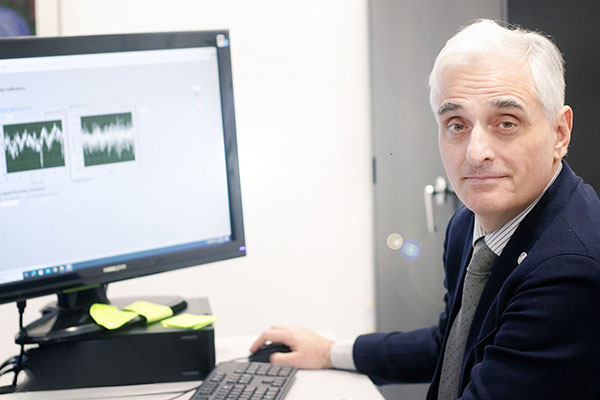Caracoglia Part of Team to Test Life Size Buildings Against Simulated Tornados

Main photo: Professor Luca Caracoglia, PhD, Fellow ASCE, works in the wind tunnel on campus. He’s now a senior researcher involved in NEWRITE, a facility design project that will test large building models against extreme winds.
CEE Professor Luca Caracoglia is part of a team of researchers across nine universities who have been given a four-year, $14 million grant by the NSF to design a facility that can test tornado effects on real-life scale building models.
CEE Professor Luca Caracoglia is part of a team of researchers across nine universities who have been given a four-year, $14 million grant by the NSF to design a facility that can test tornado effects on real-life scale building models.
While the frequency of tornadoes rises in the Southeast and Midwest US, and urbanization increases in tornado-prone areas, gleaning new insights into engineering buildings that can withstand severe winds is an important goal.
A team of researchers across nine universities has been given a four-year, $14 million grant by the NSF to design a facility that can test tornado effects on real-life scale building models. The design project, led by Iowa State Professor Partha Sakar, aims to reduce the error margin inherent in the current small-scale testing of tornado effects by increasing the scale.
Northeastern University Professor Luca Caracoglia, PhD, Fellow ASCE, is a senior researcher involved in the facility design project, which is known officially as the National Testing Facility for Enhancing Wind Resiliency of Infrastructure in Tornado-Downburst-Gust Front Events, or NEWRITE.
The facility plans to test structures under tornado loads on a more realistic scale during a tornado, Caracoglia says.
Caracoglia is focused on the response of building models in the NEWRITE design. His goal is to help plan a usable facility to withstand intense wind effects and prevent a building model from breaking with hazardous results. The safety of those working within the facility is the highest priority, he says, and it is critical to abide by the safety restrictions.
“When you run an experiment, you have to make sure it is safe,” explains Caracoglia. Safety restrictions can include design constraints, maximum flow speeds, maximum scales, and understanding the fidelity and linearity of simulated experiments.
The NEWRITE team will utilize computer models to simulate experiments before conducting them in the facility. These simulations will allow the team to predict safety concerns, and then plan protective protocols in response.
As an example, without protective protocols, “large vibrations may break the building model,” Caracogolia says.
Depending on the goal of the experiment, researchers want both positive and negative outcomes, so they learn how to best proceed. In some experiments, the model may fail or break. That may result in a decision to use safety nets to catch fractured model parts.
NEWRITE plans to test buildings at the size of a full-scale house or 1:10 scale models of larger buildings, such as shopping malls and hospitals. Tornado testing facilities currently in use test at a 1:100 scale of real-life tall buildings, explains Caracoglia.
“Building a larger facility will open up more opportunities and applications for wider use in the research community,” he says.
The NSF grant is for the design and planning of the facility, as well as a new Tornado/Microburst simulator able to produce 225 mph winds, almost three times the speed capability of the current simulator at Iowa State. However, the grant does not yet support the actual construction of the facility. Future support relies on a foolproof design.
“Funding is quite strict,” says Caracoglia. “The design must show that it is safe and sustainable before the facility can be built.”
Tornados can be harder to predict and prepare for than other natural disasters, he adds, so building structures that can withstand them is crucial. The most important buildings, including hospitals and fire stations, must be at least partially functional after a disaster.
The American Society of Civil Engineers lists important buildings that must be able to withstand disaster to protect the highest number of human life or be maintained as an “essential facility.”
“The most important thing is the safety of the building occupants,” says Caracoglia.